Updated: October 22, 2025
Written by Dan Simms
Nieves is a home remodeling editor at Fixr.com with special interest in landscaping, pest control, painting, installation, and repair projects. She brings her work ethic, creativity, and love for teamwork into everything she does, including working with writers and designers at Fixr.com to develop useful and comprehensive guides for homeowners.
Learn moreReviewed by Nieves Martinez
Your HVAC system works year-round to keep your home cool in the summer and warm in the winter. Unfortunately, this can lead to wear and tear, increasing the risk of breakdowns and shortening the system's lifespan. That’s where HVAC maintenance comes in, as it helps your system run smoothly and efficiently, extending the lifespan and potentially reducing operating costs.
The national average cost of HVAC maintenance is $275, and most homeowners pay somewhere between $150 and $350. Prices will vary based on the type of AC system you have, whether you’re scheduling a one-off service or entering into an annual contract, and whether or not you choose add-on services, like air duct cleaning.
Cost of HVAC Maintenance

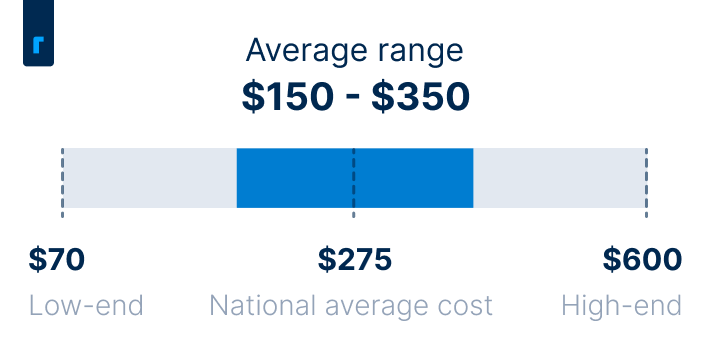
HVAC Maintenance Cost by Type of Service
A one-off HVAC maintenance service will cost an average of $275, and while you’ll pay more upfront to sign up for an annual maintenance plan, you’ll usually save money in the long run due to discounts for more work you’re guaranteeing your HVAC tech during each maintenance visit.
Annual HVAC tune-up cost: A standard annual HVAC tune-up is a basic, one-off service that you schedule each year or as you see fit. It includes a routine HVAC inspection, lubricating moving components, checking electrical connections, and ensuring general functionality. An annual tune-up costs an average of $275.
HVAC maintenance contract cost: An HVAC service contract costs between $150 and $500 per year. These may include a tune-up, but some just give you discounts on tune-ups. Most will also include discounts on service calls, preferred scheduling, and reduced emergency service fees. Companies can offer other perks, as well.
In general, HVAC maintenance contracts are more expensive, but they provide access to additional benefits. They can also end up saving you money in some cases. For example, if your HVAC system is older, and you expect you’ll need regular repairs, you might save more on HVAC service call costs, which average between $70 and $200 and cover diagnostics and minimal repairs, than you’d pay to secure the contract.
HVAC Maintenance Cost by Type of Unit
The type of HVAC equipment you have will also play a major role in your maintenance costs. A split system, the most common setup, requires your tech to inspect and service both the heating unit and the cooling equipment. A standalone central AC system or furnace requires half the work and costs much less. The complexity of the equipment matters, too, as traditional heating systems have more moving parts and a higher risk of issues stemming from the burning of fossil fuels.
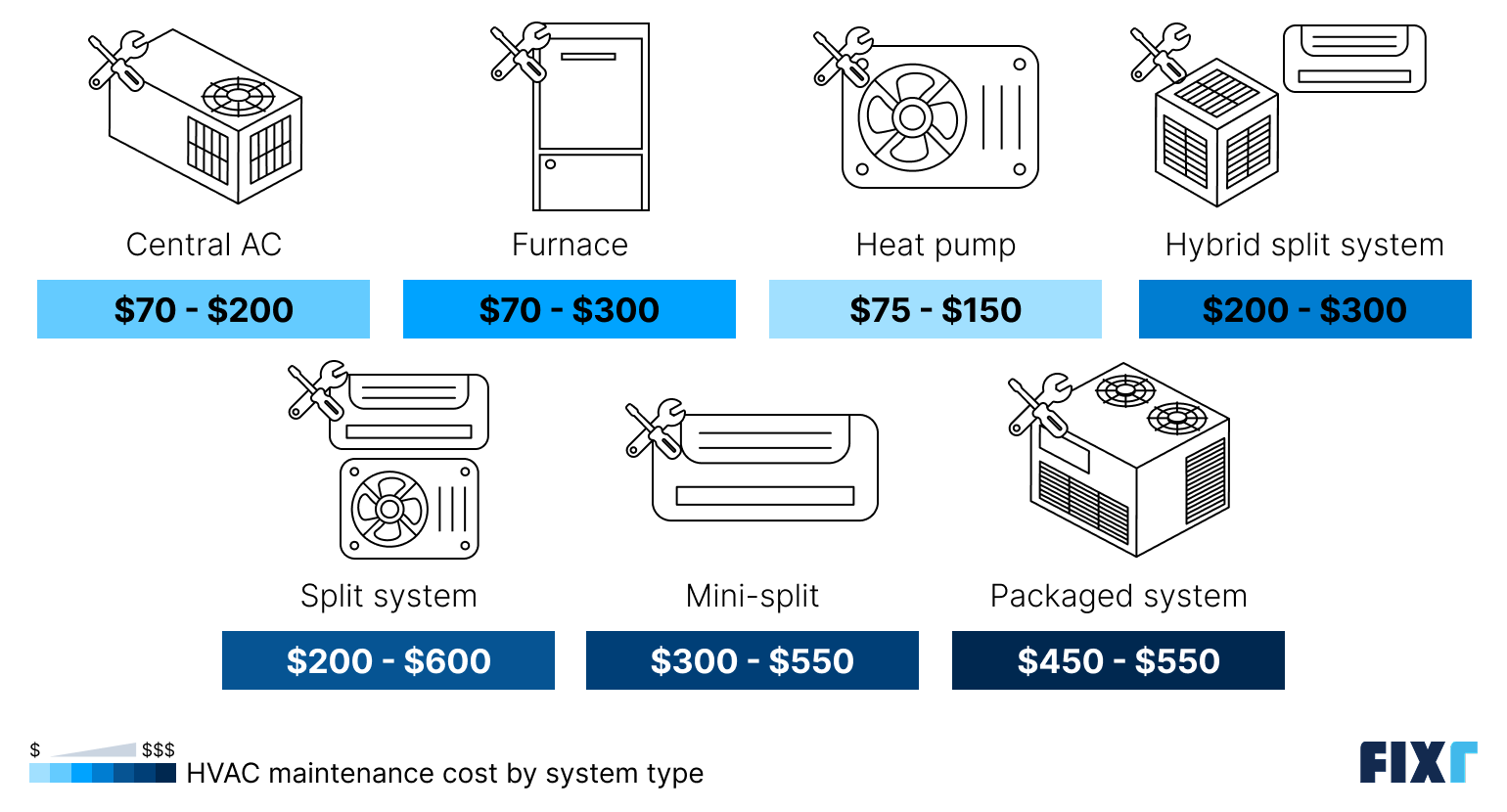
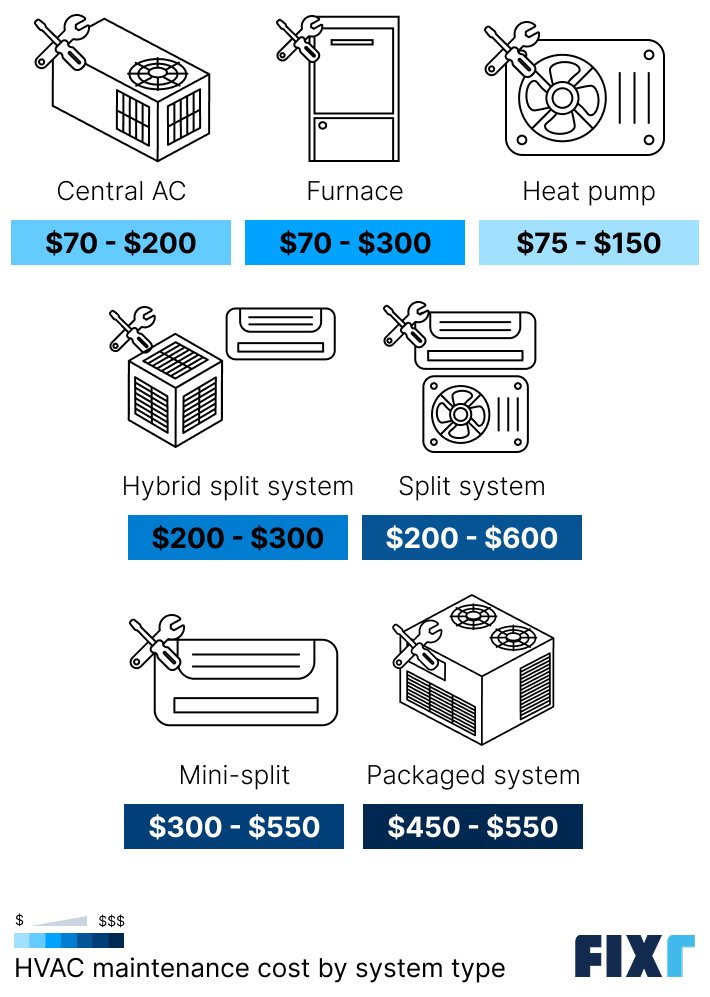
Type | Cost |
Central AC | $70 – $200 |
Furnace | $70 – $300 |
Heat pump | $75 – $150 |
Hybrid split system | $200 – $300 |
Split system | $200 – $600 |
Mini-split | $300 – $550 |
Packaged system | $450 – $550 |
Central AC
A central AC is one of the simplest systems to service, as it contains only cooling equipment. AC unit maintenance costs fall between $70 and $200. Most homes are required by law to have heating equipment, but it’s possible you may only need services for your AC system if you live in a hot climate and don’t use heat often.
According to the U.S. Department of Energy, focusing on maximizing your AC system’s efficiency can reduce cooling costs by 20% to 50%, so AC services are often worthwhile.
Furnace
A furnace maintenance service costs as little as $70. While servicing a furnace means focusing on one piece of equipment, too, the price can climb up to $300, largely because there’s more that can go wrong with a unit that burns fossil fuels. Your tech will need to check more components for safety and will often spend more time cleaning the unit than they would with a central AC system.
Heat Pump
Heat pumps cost between $75 and $150 for HVAC maintenance, making them some of the most affordable systems to service. Heat pumps use electricity and have fewer moving parts than most other systems. They’re also some of the most efficient options, which helps extend their lifespan and reduce the need for repairs. However, note that heat pump routine maintenance is recommended twice a year, once before the heating season and again before the cooling season, which doubles the total annual maintenance cost.
Hybrid Split System
A hybrid split system uses a heat pump to provide both heating and cooling, but it’s coupled with a more traditional heating system, usually a furnace, to provide ample heating in extremely cold weather. Given the additional components involved, expect maintenance for a hybrid split system to cost between $200 and $300.
Split System
Split systems are the most common HVAC systems, and they can also be the most expensive to service, with maintenance costs sitting between $200 and $600. The potentially high costs are due to the fact that you have a heating system that needs servicing, plus a standalone central AC system that needs its own servicing.
Mini-Split
Mini-splits are a type of heat pump, but the HVAC maintenance costs for mini-splits are usually higher because the systems make use of multiple indoor units, each of which needs cleaning and servicing, and long refrigerant lines that increase the risk of leaks. Maintenance for this type of system costs between $300 and $550.
Packaged System
A packaged system is like a split system, but all of the components for both heating and cooling are contained in a single enclosure. These are more common in commercial settings, but if you have one in your home, expect HVAC maintenance costs to fall between $450 and $550.
HVAC Maintenance Service Cost by Task
In addition to the type of HVAC system you have, the specific services you need can influence your maintenance costs. In most cases, you’ll need to have a tech carry out diagnostics to figure out what the underlying problem is, but if you have an idea what’s going on with your unit, you can estimate based on the specific task.
Many homeowners also choose to couple routine services with add-on services, like air duct cleaning, so you can get an idea of your total if you’re considering those add-ons.
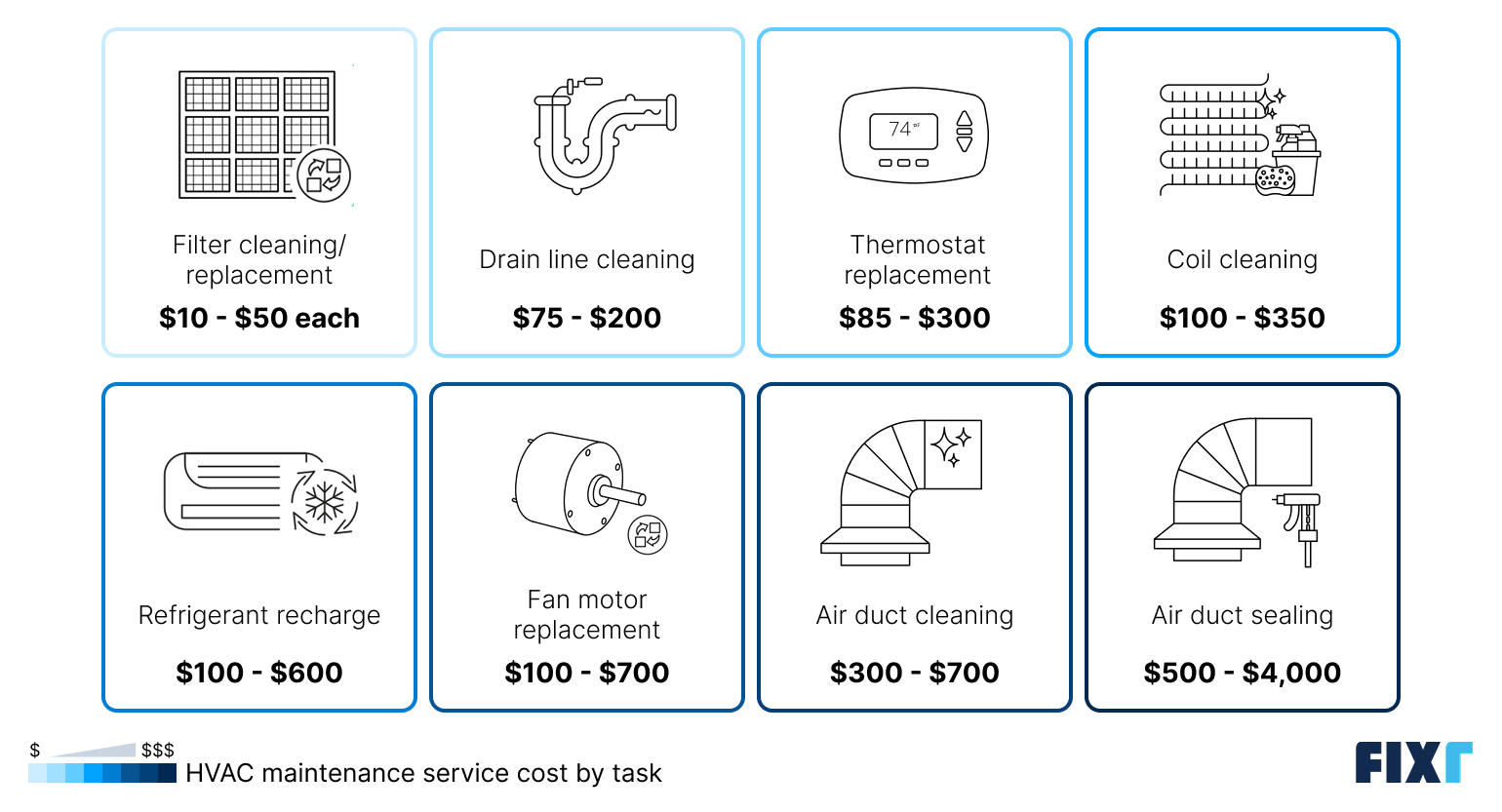
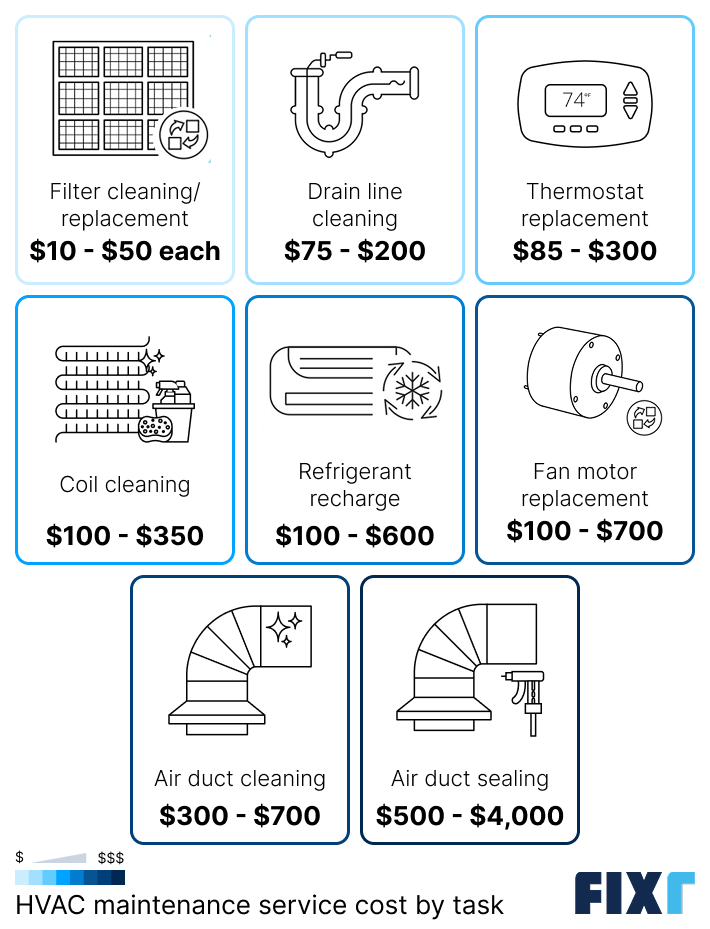
Maintenance Task | Cost |
Filter cleaning/replacement | $10 – $50 each |
Drain line cleaning | $75 – $200 |
$85 – $300 | |
Coil cleaning | $100 – $350 |
$100 – $600 | |
Fan motor replacement | $100 – $700 |
$300 – $700 | |
Air duct sealing | $500 – $4,000 |
Cost Factors
HVAC maintenance costs can range widely because there are many factors at play that can affect your pricing. These factors can cause minor variations in your base costs, but if your tech finds more severe issues that need major repairs, you’ll see much bigger HVAC maintenance price swings based on the additional work you need.
Labor Costs
Labor accounts for nearly all of your total when it comes to HVAC maintenance costs, with just a small portion going toward materials, like filters. HVAC service costs per hour range from $75 to $150, in most cases, but most techs charge flat rates for standard maintenance, like a tune-up.
Location
Where you live can impact your HVAC maintenance costs in several ways. Labor rates are typically higher in major cities and high-cost states, while your local climate affects how hard your system works and how often it needs service or repairs. Additionally, the type of HVAC system common in your area, based on electricity costs and fuel availability, can also influence overall maintenance expenses.
Frequency of Use and Climate
Your climate affects how often you rely on your system. Homes in cooler regions use AC less, leading to lower wear and costs, while systems in hot states like Florida or Texas see heavier use and higher expenses.
Environmental Factors
High pollen or humidity levels can increase maintenance needs, such as more frequent filter changes and duct cleanings. These affect wear and tear, and consequently, your maintenance schedule.
Age of the System
Newer systems run efficiently with minimal upkeep, but older units require more frequent maintenance, and they’re more likely to need repairs that can drive costs higher.
Home Size and Layout
Larger homes need bigger HVAC systems that cost more to repair. The layout of your house may also matter because it can determine how many vents, ducts, and filters require cleaning
How Often Should You Get Your HVAC Serviced?
Most HVAC professionals recommend getting your system serviced at least once a year, but this can mean different things for different types of HVAC systems. For systems that provide both heating and cooling, like a split system or a ductless mini-split, twice-a-year tune-ups are ideal, once in the spring for cooling and once in the fall for heating. Standalone central AC systems should be serviced once in the spring, and standalone heating systems need service once each fall.
Keep in mind that these are just general guidelines. How often you need maintenance depends on your climate, the age of your system, and more. While either annual or bi-annual service is standard, you should call a professional sooner if you notice any of these issues:
Unusual noises: Sounds like grinding, banging, or squealing suggest friction among moving parts that will cause dips in efficiency, higher utility bills, and a shortened system lifespan.
Poor airflow: Weak or inconsistent airflow from your vents may signal a clogged filter or a blower fan problem.
Unexplained spikes in bills: A sudden increase in your energy costs could mean that your system is running inefficiently.
Frequent cycling: If your system turns on and off more often than usual or won’t stay on for more than a few seconds, it could mean an issue with your thermostat, circuit board, or other internal components.
Leaks: Leaks around your HVAC equipment need servicing right away, not only to correct the underlying issue but also to avoid mold growth and water damage.
Is HVAC Maintenance Worth It?
While preventative HVAC maintenance may seem like an unnecessary cost, it’s typically well worth the investment. It helps improve energy efficiency, lowers utility bills, and can pay for itself over time. Regular upkeep also extends your system’s lifespan by reducing wear and catching small issues before they become costly repairs. Additionally, maintenance can improve indoor air quality by removing dust and allergens, help prevent breakdowns during peak seasons, and keep manufacturer warranties valid, potentially saving you on repair costs later.
What Does HVAC Maintenance Include?
Preventative HVAC maintenance includes a variety of tasks to ensure your system runs efficiently and reliably. The specific services can depend on your type of system and what components you have, but a basic maintenance check-up will always include an inspection, cleaning, and performance check of all components.
Here are some proactive HVAC maintenance tasks that are also common, but note that these may vary based on your HVAC tech and the system you have.
Cleaning or replacing filters: This helps improve air quality and system efficiency, and it can also boost indoor comfort for you and your family.
Inspecting and cleaning coils: Removing dirt and debris from indoor and outdoor coils helps maintain proper heat transfer in certain systems, like central ACs, heat pumps, and mini-splits.
Checking refrigerant levels: This ensures the system has a sufficient amount of refrigerant for efficient cooling.
Inspecting electrical components: Your tech should tighten all electrical connections and check voltage and amperage to prevent fire hazards, short circuits, and breakdowns.
Lubricating moving parts: This simple task reduces friction and wear on motors, bearings, and other moving components, which improves efficiency.
Flushing condensate lines: Most techs will check your condensate line for debris and flush it out to improve drainage and avoid water damage around your unit.
Thermostat calibration: Calibrating your thermostat and ensuring it’s calling for heating and cooling accurately is another common service that can do wonders for system performance.
Furnace/boiler cleaning: For heating systems that burn fossil fuels, your tech will also clean burners, test the ignition system, check the flame sensor, and inspect the heat exchanger for damage.
Some other services are more often considered add-ons and won’t be included in a standard tune-up. Ductwork cleaning, duct sealing, and replacing major parts such as a compressor, condenser, or thermostat will always be billed separately. In these cases, the technician will explain the issue and provide a written estimate before starting work.
DIY vs. Professional HVAC Maintenance
There are some HVAC maintenance tasks that you can do yourself to improve system performance and lengthen the lifespan of your equipment. These include cleaning or changing air filters once every one to three months, dusting around return vents, and cutting plant growth back away from outdoor condensers. All other tasks, like lubricating moving parts, making minor repairs, and tightening electrical connections, should be left to an expert.
A professional HVAC contractor has the specialized tools and expertise to carry out these other crucial tasks. DIY mistakes can lead to costly damage or even safety hazards like fires or gas leaks, so it’s always worth it to hire a pro. A certified HVAC technician can also help identify issues with your system that you might miss as a DIYer, potentially saving you money by avoiding breakdowns, emergency service calls, and more severe repairs.
How to Save Money on HVAC Maintenance
HVAC regular maintenance will very often save you money by extending the life of your system and reducing the risk of expensive repairs. However, the upfront cost can get pricey, especially if you have a split system that requires services for two separate systems. There are a few things you can do to help keep maintenance costs down.
Do your own upkeep: Replacing air filters every one to three months and keeping the outdoor unit clear of debris can help avoid repair costs and charges for deeper cleanings during routine services.
Get a maintenance plan: Service plans make HVAC preventative maintenance costs predictable and can save you money in the long run, especially if you have an older system that leads to frequent service calls. Many plans include discounts on replacement parts and repairs, priority scheduling, and sometimes even waived service fees.
Get multiple quotes: Always get at least three estimates from different HVAC companies near you. You can then compare to find the best value for the money.
Schedule work in the off-season: HVAC professionals are busiest in the summer and fall when heating and cooling systems are most likely to fail. Scheduling your maintenance in the late winter or early spring could get you a discount on labor costs.
FAQs
Most professionals recommend having your HVAC system serviced at least once a year if yours just provides heating or cooling. If your system provides both heating and cooling, you should aim for bi-annual service, including one in the spring and one in the fall. You may need servicing more often if you live in an extreme climate or if your system is nearing the end of its life.
The $5,000 rule for HVAC is a guideline used to help homeowners decide whether to repair or replace their HVAC system. You multiply the age of your unit by the estimated cost of the repair. If the resulting number is more than $5,000, you’re likely to save money in the long run if you opt to replace the system rather than repair it. This is not a perfect science, so you should consult with your HVAC tech for their opinion, as well.
The average cost for HVAC maintenance ranges from $150 to $350, but the total depends on the type of system you have, your climate, the unit’s age, and more.
Yes, preventative HVAC maintenance is almost always a valuable investment. It helps your system run more efficiently, which can lead to lower energy bills and an extended lifespan for your HVAC unit. It can also help predict problems and breakdowns, which can mean minor repairs rather than more invasive and expensive ones. Many manufacturers also require proof of annual maintenance to keep your warranty valid, which can save you from paying for major HVAC repairs out of pocket.
HVAC maintenance plan costs typically do not include repairs. Instead, your technician will identify issues and provide estimates for the necessary repairs. However, many plans offer significant discounts on both parts and labor repairs, which can end up saving you money if something goes wrong. Maintenance plans also often come with perks like priority scheduling and waived service fees that can lead to savings over time.
